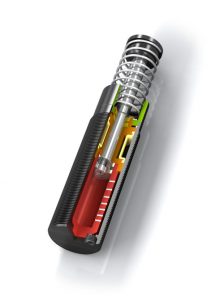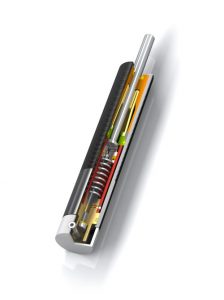By Doug Palmer, Senior Engineer, ACE Controls
Industrial shock absorbers and linear dampers work to provide a smooth, linear deceleration of a given load. Hydraulic shock absorbers and linear dampers use a medium such as transmission fluid or silicone oil to control the deceleration of the load. Pneumatic linear dampers use air or nitrogen to achieve the same goal. While their performance may be achieved using similar means, their applications are very different.
A linear damper (also known as a velocity controller)—whether hydraulic or pneumatic—is used when a load is in constant contact with the damper and the operator wants a smooth deceleration in either the compression or tension direction. Common applications where a linear damper may be found would be on garage doors, storm doors and tool feed units. In these examples, the load is in contact with the damper when the deceleration starts. That is, there is no impact of the damper by the load. That is the key difference between a damper and a shock absorber.
An industrial shock absorber, while using a similar medium to decelerate a load, is designed to “capture and control” the load as it comes into contact with the shock. The shock absorber is designed so that as the load makes contact, the shock accepts the load and gradually decelerates the load through its stroke. If properly sized, the shock absorber will “catch” the load and over the stroke of the shock, gradually “control” the load until it reaches the end of the shock’s stroke. During this stroke, the velocity of the mass is gradually decreased until it finally reaches a full and complete stop. You know that the shock absorber is doing its job if the mass doesn’t bounce at either the beginning or end of stroke. If there is a bounce at either extreme, it’s a sign that the shock absorber selected is either the wrong shock or is adjusted incorrectly. The goal of the shock absorber is to maintain a constant reaction force throughout the stroke.
Depending on the application, either a linear damper or an industrial shock absorber can perform the job of decelerating a mass. But to choose the correct piece of equipment, it is important to understand both your own application and how the damper/shock will be asked to perform. In either case, the properly sized and selected damper/shock can extend the life of your equipment and protect your investment from an early demise.
Filed Under: Fluid Power Basics

